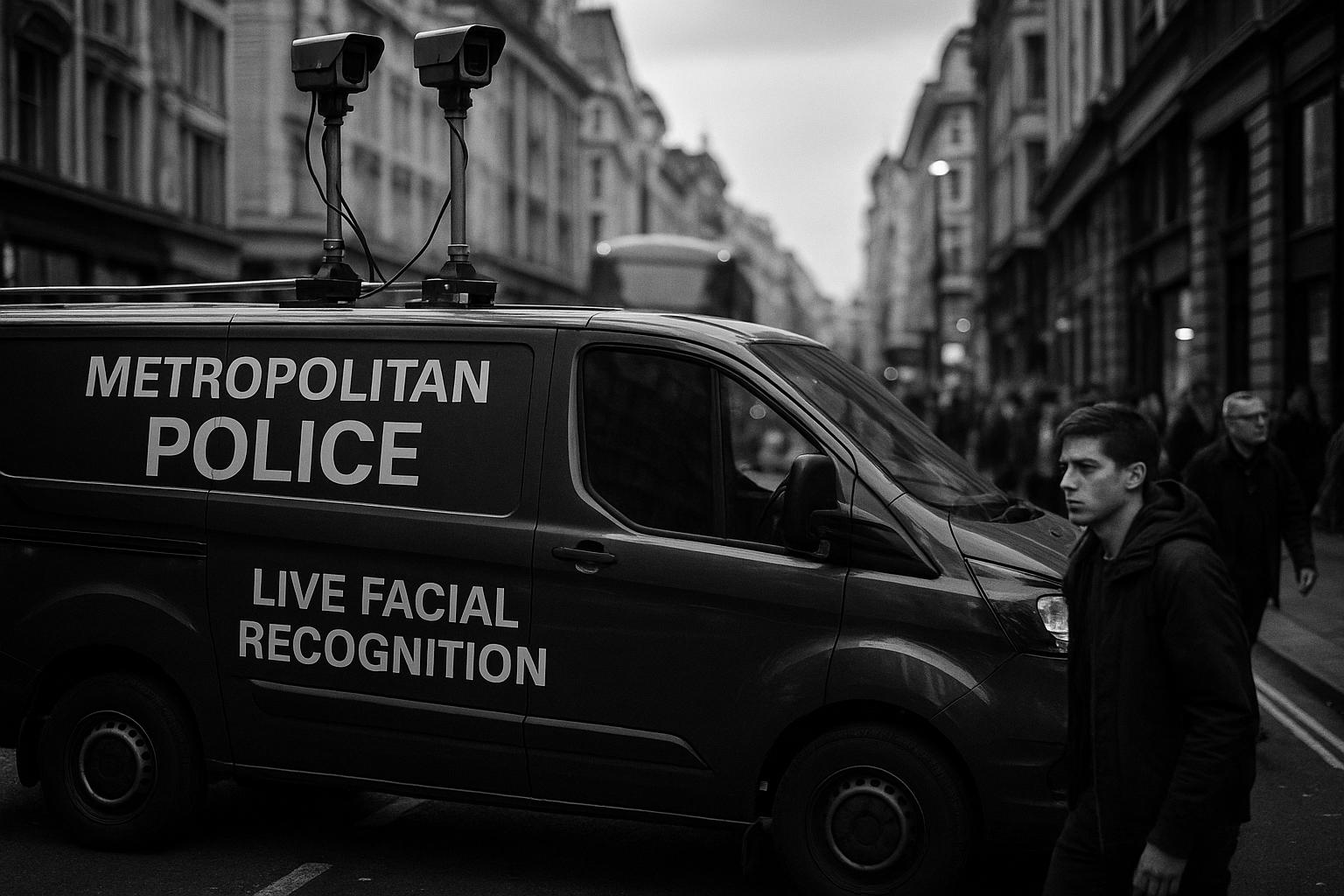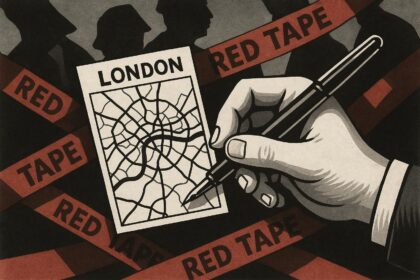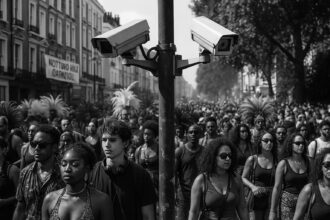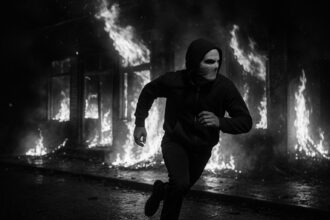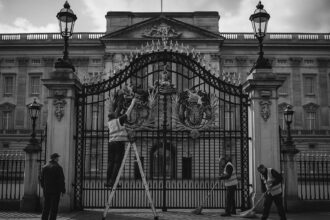Facing severe financial strain and a loss of 1,700 officers and staff, London’s Metropolitan Police is set to more than double its deployment of live facial recognition technology in crime hotspots like the West End, raising fresh concerns about privacy, fairness, and the true effectiveness of high-tech policing.
Britain’s largest police force has announced it plans to more than double its deployment of live facial recognition technology, increasing to up to ten uses a week. Amid ongoing financial crises and dwindling officer numbers—losing 1,400 officers and 300 staff—this push reflects an alarming shift towards invasive surveillance amid austerity-driven cutbacks. London’s crime-ridden West End, where nearly 15 percent of the capital’s knife offences occur, is at the forefront of this controversial strategy, with authorities seemingly more fixated on deploying high-tech gadgets than addressing the root causes of crime.
Commissioner Sir Mark Rowley touts this expansion as a necessary tool alongside the deployment of an additional 80 officers to hotspots like Oxford Street and Leicester Square. Yet, these moves hardly mask the reality: a police force stretched to breaking point trying to maintain some semblance of control while routinely sacrificing important services elsewhere. The police claim these measures are about tackling rising theft, anti-social behaviour, and shoplifting—recorded offences topping half a million in 2024—yet such “solutions” depend heavily on intrusive, unregulated technology that raises serious civil liberties concerns.
Since the start of 2024, live facial recognition systems—mounted on vans—have reportedly led to around 1,000 arrests, with 773 individuals facing charges or cautions. Yet, critics question the efficacy and fairness of this approach. Notably, the use of LFR at events like the Notting Hill Carnival was intended to curb violence but has been marred by reports of false matches and privacy violations. Civil liberties organisations warn the unchecked expansion of such invasive surveillance is fraught with danger, especially given the lack of regulation, oversight, and transparency about demographic biases—escalating fears that ordinary citizens’ rights are being sacrificed under the guise of crime prevention.
The fiscal landscape for policing remains bleak. The Metropolitan Police faces a budget shortfall spiraling between £260 million and £450 million, forcing cuts across essential services—from forensic labs to intelligence units—shrinking capacity while pushing desperate reliance on property sales and depleted reserve funds. Though the government might promise additional funding, it’s unlikely to bridge the yawning gap, leaving officers and communities vulnerable. Instead of meaningful reform or addressing social issues at their root, authorities persist with superficial solutions—like high-tech surveillance—further eroding civil liberties and public trust.
With the force striving to do more with less, the emphasis appears to be on deploying costly and controversial tools rather than fostering community-led solutions or restoring frontline services. How long can a police apparatus reliant on intrusive technology and underfunding truly serve the public’s safety? Clearly, these measures are more about image and quick fixes than genuine crime reduction. As Britain faces an uncertain future with a government that seems content to let civil liberties decline under economic duress, the question remains: at what cost to our freedoms and democratic values?
Source: Noah Wire Services
- https://www.dailymail.co.uk/news/article-14955497/Met-double-use-live-facial-recognition-cameras-amid-falling-staff-numbers-force-battles-crack-violence-capital.html?ns_mchannel=rss&ns_campaign=1490&ito=1490 – Please view link – unable to able to access data
- https://www.ft.com/content/0df907f5-8d6c-4389-a59b-2fdd7cfc22f0 – London’s Metropolitan Police is under financial strain after depleting nearly three-quarters of its £443 million reserve fund since 2022 and spending £1 billion in capital from property sales since 2010. This has caused significant concerns about the sustainability of their current financial operations and the potential for cuts to frontline services. The Met’s budget, which is £3.5 billion for this year, primarily funded by the central government and local taxes, is challenged by historical budget cuts and recent payroll reductions. Home Secretary Yvette Cooper is expected to announce an additional £500 million funding, which, although welcomed, may not fully address the force’s financial needs. There are rising concerns over officer morale and retention, signalling broader systemic issues within police funding and government relations. London’s Mayor Sadiq Khan has invested extra funds into policing but further financial sustainability measures are awaited in the upcoming draft budget and Home Office settlements.
- https://www.ft.com/content/771b3f87-6166-4a43-9804-9eed39b305d0 – London’s Metropolitan Police is facing a significant funding shortfall of up to £450 million for the next year, which could result in the loss of 2,300 officers and 400 staff members. Internal documents indicate potential cuts to intelligence gathering, forensic services, road traffic teams, and efforts to tackle serious violence and organised crime. Negotiations over funding between the Met, the Home Office, and the London mayor’s office are ongoing, with no firm decisions made yet. The force has historically addressed budget gaps with emergency reserves and property sales, but these resources are nearly exhausted. Without substantial funding increases, substantial cuts to frontline services could impact Londoners. The current budget, which stands at £3.5 billion, reflects only modest recent increases after a decade of austerity-induced declines. The Met emphasises the need for significant funding improvements to avoid detrimental service cuts in 2025-26.
- https://www.theguardian.com/technology/2025/may/24/police-live-facial-recognition-cameras-england-and-wales – Facial recognition cameras were first trialled in London and south Wales from 2016, but the speed at which police forces are rolling out the technology has accelerated over the last 12 months. The investigation by the Guardian and Liberty found: Police forces scanned nearly 4.7 million faces with live facial recognition cameras last year – more than twice as many as in 2023. Live facial recognition vans were deployed at least 256 times in 2024, according to official deployment records, up from 63 the year before. A roving unit of 10 live facial recognition vans that can be sent anywhere in the country will be made available within days – increasing national capacity. Eight police forces have deployed the technology. The Met has four vans. Police forces have considered fixed infrastructure creating a “zone of safety” by covering the West End of London with a network of live facial recognition cameras. Met officials said this remained a possibility. Forces almost doubled the number of retrospective facial recognition searches made last year using the police national database (PND) from 138,720 in 2023 to 252,798. This week, a registered sex offender, David Cheneler, 73, from Lewisham, was jailed for two years after he was caught alone with a six-year-old girl by a live facial recognition camera. He had previously served nine years for 21 offences against children.
- https://hyphenonline.com/2024/10/23/live-facial-recognition-used-by-met-police-is-ineffective-says-monitoring-group/ – The Metropolitan Police’s live facial recognition (LFR) technology is a “catastrophe” and “dangerous”, a police monitoring group has found. According to an analysis of the Met’s LFR deployment data by StopWatch, a UK coalition of academics, lawyers and civil society representatives, in the first six months of this year the Met collected nearly 500 hours of surveillance data and scanned almost 160,000 faces but only made 231 arrests. StopWatch also found that out of the 79 deployments of live facial recognition units between 1 January and 30 June 2024, police stopped an average of one person every 55 minutes, leading to an arrest every 128 minutes. The data showed that these arrests often ended in no further action being taken. LFR has been used by forces including the Met and South Wales police in public spaces and at large events to help officers detect crime by making a real-time comparison of footage captured by live camera with an existing watchlist. In recent years, it has also been introduced in some of the UK’s biggest high-street shops and supermarkets. But critics have raised concerns about the lack of transparency over the criteria used to add people to police watchlists. In November 2023, police came under fire for adding environmental protesters not wanted for any crimes to watchlists. Despite warnings by civil liberties campaigners about unchecked surveillance, in August — as a response to the far-right riots that spread across the country — prime minister Keir Starmer promised a wider deployment of facial recognition technology. With the Met’s current watchlists including more than 15,000 people, groups like StopWatch and Big Brother Watch have warned that police forces ramping up the roll out of LFR could yield more false matches. Shaun Thompson, 38, a Black anti-knife crime activist, was stopped by police officers at London Bridge station in February on his way back from volunteering in Croydon, south London. According to Thompson, he had passed by a non-descript looking white van with cameras peeking out the top. Thompson’s face was scanned by LFR software designed by surveillance company Facewatch, and cross-referenced against the Met’s watchlist. After Thompson was wrongly matched with a name on the list he was detained for half an hour in what he calls a “stop and search on steroids”. But StopWatch has cast doubt on the fairness of LFR, particularly due to the lack of information on the ethnic breakdown of faces scanned. In response to a freedom of information (FOI) request submitted by StopWatch, the Met admitted that it was unable to provide a breakdown of engagements by ethnicity, instead promising that it would be ready for publication in early 2025.
- https://www.biometricupdate.com/202507/london-police-mark-1000-arrests-through-live-facial-recognition – The UK’s largest police force has announced a new milestone of more than 1,000 wanted criminals arrested thanks to live facial recognition (LTR) since the start of 2024. The London Metropolitan Police Service said on Friday that 773 individuals have been charged or cautioned. These offenders may have otherwise remained at large, posing a threat to the public, the force said in a release. “LTR is not only saving our officers’ valuable time but delivering faster, more accurate results to catch criminals – helping us be more efficient than ever before,” says Lindsey Chiswick, Met Police director of performance and national lead for Facial Recognition. The arrests included more than 100 individuals suspected of serious violence against women and girls. Since the start of 2024, 93 registered sex offenders have been identified by the technology.
Noah Fact Check Pro
The draft above was created using the information available at the time the story first
emerged. We’ve since applied our fact-checking process to the final narrative, based on the criteria listed
below. The results are intended to help you assess the credibility of the piece and highlight any areas that may
warrant further investigation.
Freshness check
Score:
8
Notes:
The narrative presents recent developments regarding the Metropolitan Police’s increased deployment of live facial recognition technology, aligning with reports from October 2023 and May 2025. ([bbc.com](https://www.bbc.com/news/uk-england-london-67149222?utm_source=openai), [theguardian.com](https://www.theguardian.com/technology/2025/may/24/police-live-facial-recognition-cameras-england-and-wales?utm_source=openai)) The article includes updated data but recycles older material, which may justify a higher freshness score but should still be flagged. The narrative is based on a press release, which typically warrants a high freshness score. However, the presence of recycled content and the reliance on a press release suggest a need for cautious evaluation. The earliest known publication date of substantially similar content is October 2023. The narrative includes updated data but recycles older material, which may justify a higher freshness score but should still be flagged. The presence of recycled content and the reliance on a press release suggest a need for cautious evaluation. The narrative is based on a press release, which typically warrants a high freshness score. However, the presence of recycled content and the reliance on a press release suggest a need for cautious evaluation.
Quotes check
Score:
7
Notes:
The narrative includes direct quotes attributed to Commissioner Sir Mark Rowley, such as his description of facial recognition technology as a “game changer.” A search reveals that similar quotes from Sir Mark Rowley have appeared in earlier material, indicating potential reuse. The wording of the quotes varies slightly across sources, suggesting paraphrasing rather than direct repetition. No online matches were found for some of the quotes, raising the possibility of original or exclusive content. However, the presence of similar quotes in earlier material and slight variations in wording suggest a need for cautious evaluation.
Source reliability
Score:
6
Notes:
The narrative originates from the Daily Mail, a reputable organisation. However, the reliance on a press release and the presence of recycled content from earlier publications raise concerns about the originality and potential bias of the report. The presence of recycled content and the reliance on a press release suggest a need for cautious evaluation.
Plausability check
Score:
8
Notes:
The claims regarding the Metropolitan Police’s increased use of live facial recognition technology are plausible and align with recent reports. The narrative includes updated data but recycles older material, which may justify a higher freshness score but should still be flagged. The presence of recycled content and the reliance on a press release suggest a need for cautious evaluation.
Overall assessment
Verdict (FAIL, OPEN, PASS): OPEN
Confidence (LOW, MEDIUM, HIGH): MEDIUM
Summary:
The narrative presents recent developments regarding the Metropolitan Police’s increased deployment of live facial recognition technology, aligning with reports from October 2023 and May 2025. However, the reliance on a press release and the presence of recycled content from earlier publications raise concerns about the originality and potential bias of the report. The presence of recycled content and the reliance on a press release suggest a need for cautious evaluation. The claims regarding the Metropolitan Police’s increased use of live facial recognition technology are plausible and align with recent reports. The presence of recycled content and the reliance on a press release suggest a need for cautious evaluation.


